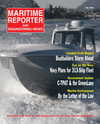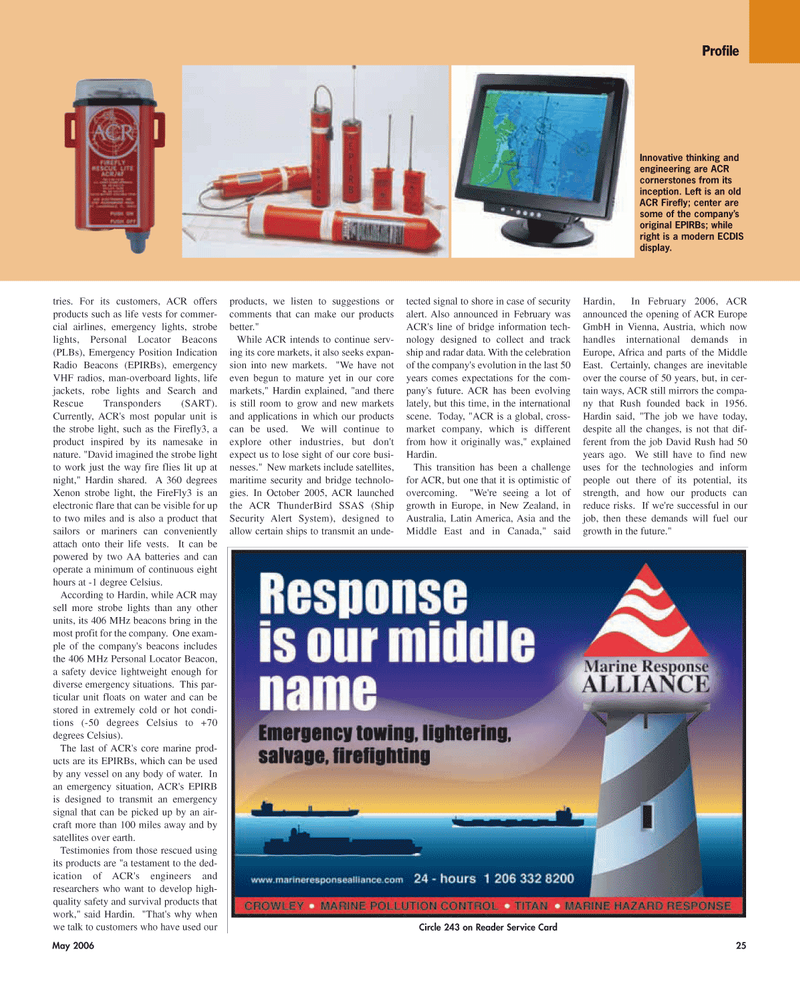
Page 25: of Maritime Reporter Magazine (May 2006)
The Marine Enviroment
Read this page in Pdf, Flash or Html5 edition of May 2006 Maritime Reporter Magazine
May 2006 25 tries. For its customers, ACR offers products such as life vests for commer- cial airlines, emergency lights, strobe lights, Personal Locator Beacons (PLBs), Emergency Position Indication
Radio Beacons (EPIRBs), emergency
VHF radios, man-overboard lights, life jackets, robe lights and Search and
Rescue Transponders (SART).
Currently, ACR's most popular unit is the strobe light, such as the Firefly3, a product inspired by its namesake in nature. "David imagined the strobe light to work just the way fire flies lit up at night," Hardin shared. A 360 degrees
Xenon strobe light, the FireFly3 is an electronic flare that can be visible for up to two miles and is also a product that sailors or mariners can conveniently attach onto their life vests. It can be powered by two AA batteries and can operate a minimum of continuous eight hours at -1 degree Celsius.
According to Hardin, while ACR may sell more strobe lights than any other units, its 406 MHz beacons bring in the most profit for the company. One exam- ple of the company's beacons includes the 406 MHz Personal Locator Beacon, a safety device lightweight enough for diverse emergency situations. This par- ticular unit floats on water and can be stored in extremely cold or hot condi- tions (-50 degrees Celsius to +70 degrees Celsius).
The last of ACR's core marine prod- ucts are its EPIRBs, which can be used by any vessel on any body of water. In an emergency situation, ACR's EPIRB is designed to transmit an emergency signal that can be picked up by an air- craft more than 100 miles away and by satellites over earth.
Testimonies from those rescued using its products are "a testament to the ded- ication of ACR's engineers and researchers who want to develop high- quality safety and survival products that work," said Hardin. "That's why when we talk to customers who have used our products, we listen to suggestions or comments that can make our products better."
While ACR intends to continue serv- ing its core markets, it also seeks expan- sion into new markets. "We have not even begun to mature yet in our core markets," Hardin explained, "and there is still room to grow and new markets and applications in which our products can be used. We will continue to explore other industries, but don't expect us to lose sight of our core busi- nesses." New markets include satellites, maritime security and bridge technolo- gies. In October 2005, ACR launched the ACR ThunderBird SSAS (Ship
Security Alert System), designed to allow certain ships to transmit an unde- tected signal to shore in case of security alert. Also announced in February was
ACR's line of bridge information tech- nology designed to collect and track ship and radar data. With the celebration of the company's evolution in the last 50 years comes expectations for the com- pany's future. ACR has been evolving lately, but this time, in the international scene. Today, "ACR is a global, cross- market company, which is different from how it originally was," explained
Hardin.
This transition has been a challenge for ACR, but one that it is optimistic of overcoming. "We're seeing a lot of growth in Europe, in New Zealand, in
Australia, Latin America, Asia and the
Middle East and in Canada," said
Hardin, In February 2006, ACR announced the opening of ACR Europe
GmbH in Vienna, Austria, which now handles international demands in
Europe, Africa and parts of the Middle
East. Certainly, changes are inevitable over the course of 50 years, but, in cer- tain ways, ACR still mirrors the compa- ny that Rush founded back in 1956.
Hardin said, "The job we have today, despite all the changes, is not that dif- ferent from the job David Rush had 50 years ago. We still have to find new uses for the technologies and inform people out there of its potential, its strength, and how our products can reduce risks. If we're successful in our job, then these demands will fuel our growth in the future."
Profile
Innovative thinking and engineering are ACR cornerstones from its inception. Left is an old
ACR Firefly; center are some of the company’s original EPIRBs; while right is a modern ECDIS display.
Circle 243 on Reader Service Card
MR MAY2006 #3 (17-24).qxd 5/8/2006 11:28 AM Page 25

 24
24

 26
26
